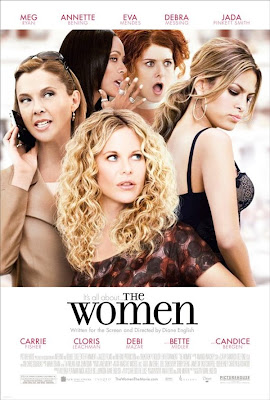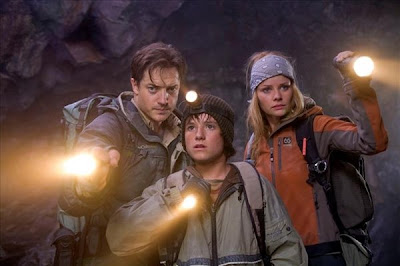
Jerry Shaw: Shia LaBeouf
Rachel Holloman: Michelle Monaghan
Zoe Perez: Rosario Dawson
Agent Tom Morgan: Billy Bob Thornton
Defense Secretary Callister: Michael Chiklis
Major William Bowman: Anthony Mackie
DreamWorks SKG presents a film directed by D.J. Caruso. Written by John Glenn & Travis Adam Wright and Hillary Seitz and Dan McDermott. Running time: 118 min. Rated PG-13 (for intense sequences of action and violence, and for language).
“If a butterfly flaps its wings in China, will it rain in London?”
There are as many variations on this saying—known as “the butterfly effect”—as the infinite possibilities that the Chaos Theory behind it suggests. But chaos does not apply to the modern action thriller. The plots are too structured and intricate to allow for variants of any kind. Even when a plot seems to allow freedom of choice for its characters, that freedom is usually an illusion of the plot that is either well hidden or not. “Eagle Eye” is one of those movies with a plot so preposterous that even the slightest notion of random elements have been vanquished from the script.
Chaos works against a movie like this. Like in a scene where the movie’s hero is in a car that has been picked up by a giant crane, and the villain’s plan depends upon the hero jumping out of the car at a specific point. Before the action reaches that point the car’s front window must fall out so the hero can jump through it. In order to achieve this the villain allows the crane to tip the vehicle forward, but how does the villain know the hero will maintain his grip on the car’s dashboard long enough to make it to the point where he must jump from the vehicle? The villain eventually explains some computer program that allows for the perfect personality test, which tells exactly how a person can be manipulated, but no personality test could determine whether someone will loose his grip for a million other unpredictable reasons.
But I’ve gotten ahead of myself. The hero is Jerry Shaw, a loser who has dropped out of Stanford, can’t keep a steady relationship, works at the Copy Cabana, and can’t even pay rent on his dump of an apartment. There is one thing special about Jerry. His is a twin. His brother excelled at everything he did. He was living a successful career with the Air Force, when he was killed in a car accident.
When Jerry returns from his brother’s funeral, he finds things have changed in his life. His bank account now has $750,000 in it, and his apartment is filled with state of the art military weapons and deadly chemicals. He receives a phone call in which he is told the FBI will be there in 30 seconds and that he must get out of the apartment. He doesn’t. But after a cool-tempered anti-terrorism agent played by Billy Bob Thornton tells Jerry he’s in “a lot of trouble,” Jerry is forced to escape and follow the instructions of the mysterious voice that is able to call him on any phone and is aware of his every movement.
Jerry is not the only innocent pulled into this sinister mystery plot. Rachel Holloman is a single mother forced into the plot for fear of her son’s life, although it seems the villain’s scheme would have been more efficient by only involving her son and leaving her out of it. But then Jerry wouldn’t have anyone to work off.
Shia LaBeouf (“Indiana Jones and the Kingdom of the Crystal Skull”) continues to prove he is a compelling actor to watch on screen with his ability to make Jerry a believable hero. And Michelle Monaghan (“Mission Impossible III”) is appropriately desperate to save her son as Rachel. But neither actor seems to grasp the absurdity of their characters’ use in the plot. For a movie that is all situation, these two actually seem to think this is all about them.
Thornton is as smooth as ever as Agent Morgan, although he conveniently buys into the alternate theory he has fought against for the entire film at just the point he must. That theory that Jerry and Rachel are being manipulated is presented by an Air Force investigator played by Rosario Dawson (“Clerks II”). Although it is nice to see Dawson get a shot at a high profile role, she isn’t given much to do beyond figure out what is really happening pretty much by accident. Michael Chiklis (FX’s “The Shield”) is given a good opening scene as the Secretary of Defense, but is quickly lost in the movie’s design.
Director D.J. Caruso teams up with LaBeouf a second time, their first collaboration being the Hitchcockian movie “Disturbia”. And although he has once again cast LaBeouf as another Hitchcockian hero—the falsely accused man—the direction is not handled with the perfection of style as a Hitchcock. The fast-paced quick cuts of many of the action sequences are confusing; especially when so many of the vehicles look alike. And he has a tendency to move his camera without purpose.
I suppose if you can overlook the chaos theory that acts against the intricately detailed plot developed by the villain, this may be an effective thriller for you. But there are just too many things this plot depends on going perfectly in order for it to play out. And the only time things don’t work the way they are supposed to for the villain are when the script requires the characters to break away from the restrictions placed on them. “Eagle Eye” could use just a little more chance in its stratagem.
Rachel Holloman: Michelle Monaghan
Zoe Perez: Rosario Dawson
Agent Tom Morgan: Billy Bob Thornton
Defense Secretary Callister: Michael Chiklis
Major William Bowman: Anthony Mackie
DreamWorks SKG presents a film directed by D.J. Caruso. Written by John Glenn & Travis Adam Wright and Hillary Seitz and Dan McDermott. Running time: 118 min. Rated PG-13 (for intense sequences of action and violence, and for language).
“If a butterfly flaps its wings in China, will it rain in London?”
There are as many variations on this saying—known as “the butterfly effect”—as the infinite possibilities that the Chaos Theory behind it suggests. But chaos does not apply to the modern action thriller. The plots are too structured and intricate to allow for variants of any kind. Even when a plot seems to allow freedom of choice for its characters, that freedom is usually an illusion of the plot that is either well hidden or not. “Eagle Eye” is one of those movies with a plot so preposterous that even the slightest notion of random elements have been vanquished from the script.
Chaos works against a movie like this. Like in a scene where the movie’s hero is in a car that has been picked up by a giant crane, and the villain’s plan depends upon the hero jumping out of the car at a specific point. Before the action reaches that point the car’s front window must fall out so the hero can jump through it. In order to achieve this the villain allows the crane to tip the vehicle forward, but how does the villain know the hero will maintain his grip on the car’s dashboard long enough to make it to the point where he must jump from the vehicle? The villain eventually explains some computer program that allows for the perfect personality test, which tells exactly how a person can be manipulated, but no personality test could determine whether someone will loose his grip for a million other unpredictable reasons.
But I’ve gotten ahead of myself. The hero is Jerry Shaw, a loser who has dropped out of Stanford, can’t keep a steady relationship, works at the Copy Cabana, and can’t even pay rent on his dump of an apartment. There is one thing special about Jerry. His is a twin. His brother excelled at everything he did. He was living a successful career with the Air Force, when he was killed in a car accident.
When Jerry returns from his brother’s funeral, he finds things have changed in his life. His bank account now has $750,000 in it, and his apartment is filled with state of the art military weapons and deadly chemicals. He receives a phone call in which he is told the FBI will be there in 30 seconds and that he must get out of the apartment. He doesn’t. But after a cool-tempered anti-terrorism agent played by Billy Bob Thornton tells Jerry he’s in “a lot of trouble,” Jerry is forced to escape and follow the instructions of the mysterious voice that is able to call him on any phone and is aware of his every movement.
Jerry is not the only innocent pulled into this sinister mystery plot. Rachel Holloman is a single mother forced into the plot for fear of her son’s life, although it seems the villain’s scheme would have been more efficient by only involving her son and leaving her out of it. But then Jerry wouldn’t have anyone to work off.
Shia LaBeouf (“Indiana Jones and the Kingdom of the Crystal Skull”) continues to prove he is a compelling actor to watch on screen with his ability to make Jerry a believable hero. And Michelle Monaghan (“Mission Impossible III”) is appropriately desperate to save her son as Rachel. But neither actor seems to grasp the absurdity of their characters’ use in the plot. For a movie that is all situation, these two actually seem to think this is all about them.
Thornton is as smooth as ever as Agent Morgan, although he conveniently buys into the alternate theory he has fought against for the entire film at just the point he must. That theory that Jerry and Rachel are being manipulated is presented by an Air Force investigator played by Rosario Dawson (“Clerks II”). Although it is nice to see Dawson get a shot at a high profile role, she isn’t given much to do beyond figure out what is really happening pretty much by accident. Michael Chiklis (FX’s “The Shield”) is given a good opening scene as the Secretary of Defense, but is quickly lost in the movie’s design.
Director D.J. Caruso teams up with LaBeouf a second time, their first collaboration being the Hitchcockian movie “Disturbia”. And although he has once again cast LaBeouf as another Hitchcockian hero—the falsely accused man—the direction is not handled with the perfection of style as a Hitchcock. The fast-paced quick cuts of many of the action sequences are confusing; especially when so many of the vehicles look alike. And he has a tendency to move his camera without purpose.
I suppose if you can overlook the chaos theory that acts against the intricately detailed plot developed by the villain, this may be an effective thriller for you. But there are just too many things this plot depends on going perfectly in order for it to play out. And the only time things don’t work the way they are supposed to for the villain are when the script requires the characters to break away from the restrictions placed on them. “Eagle Eye” could use just a little more chance in its stratagem.



 She Said / ***
She Said / ***




